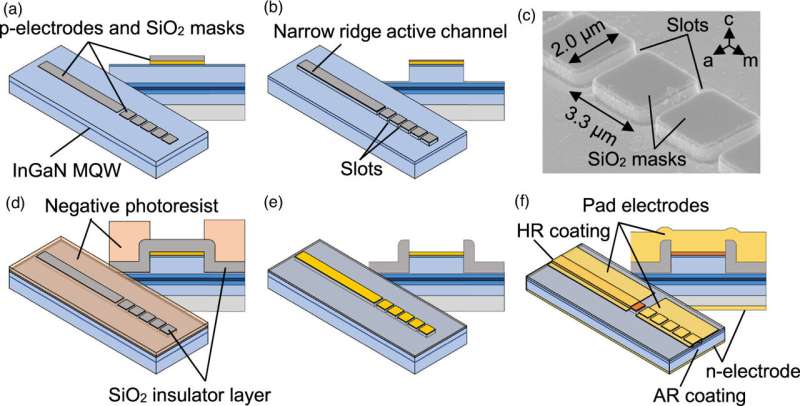
Fabrication process. (a) Formation of p-electrodes and etching masks. (b) Formation of active and slotted channels. (c) SEM image of slotted channel. (d) Deposition of insulator layer and photoresist opening. (e) Insulator layer opening. (f) Metallization and facet coating. Credit: Applied Physics Express (2024).
In a new study, researchers at Osaka University have created the world’s first compact, tunable-wavelength blue semiconductor laser, a significant advancement for far-ultraviolet light technology with promising applications in sterilization and disinfection.
This innovative laser employs a specially-designed periodically slotted structure in nitride semiconductors, making possible a blue wavelength laser that is both practical and adaptable for various disinfection technologies. The work is published in the journal Applied Physics Express.
The research team had previously demonstrated second-harmonic generation at wavelengths below 230 nm by using transverse quasi-phase-matching devices crafted from aluminum nitride and vertical microcavity wavelength conversion devices incorporating SrB4O7 nonlinear optical crystals.
Usually, these advanced devices require large, costly ultrashort-pulse lasers as excitation sources. However, realizing a practical far-ultraviolet light source requires a blue semiconductor laser with a wavelength around 460 nm.
Originally designed for Blu-ray technology, blue nitride semiconductor lasers have expanded in use to the processing of metallic materials like copper and gold, with anticipated applications in next-generation laser displays. However, these blue lasers oscillate at multiple wavelengths.
High-efficiency wavelength conversion devices have a very narrow wavelength acceptance bandwidth, making single-wavelength lasers ideal as excitation sources. Furthermore, precise wavelength control and tunability are essential. Although several single-wavelength blue lasers with coarse periodic structures have been reported, none have achieved tunable wavelength control.
“Our tunable-wavelength nitride semiconductor laser oscillates in the 405 nm band, but its structure can be readily adapted to the 460 nm band as well,” explains first author Taisei Kusui. “Combined with our new wavelength conversion devices, this laser enables the creation of a compact, practical far-ultraviolet light source that is safe for continuous use in indoor environments, providing effective and ongoing sterilization and disinfection.”
With its compact design and extended lifespan, this technology could be seamlessly integrated into household appliances like refrigerators and air conditioners, contributing to a healthier and safer living environment with wide-reaching public health benefits.
Disclaimers of Warranties
1. The website does not warrant the following:
1.1 The services from the website meets your requirement;
1.2 The accuracy, completeness, or timeliness of the service;
1.3 The accuracy, reliability of conclusions drawn from using the service;
1.4 The accuracy, completeness, or timeliness, or security of any information that you download from the website
2. The services provided by the website is intended for your reference only. The website shall be not be responsible for investment decisions, damages, or other losses resulting from use of the website or the information contained therein<
Proprietary Rights
You may not reproduce, modify, create derivative works from, display, perform, publish, distribute, disseminate, broadcast or circulate to any third party, any materials contained on the services without the express prior written consent of the website or its legal owner.


.jpg?w=428&resize=428,400)
